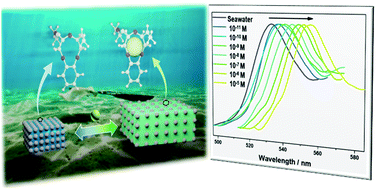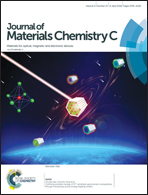Photonic hydrogels for the ultratrace sensing of divalent beryllium in seawater†
Abstract
Responsive photonic hydrogels functionalized with crown ether molecules containing the smallest cavities are designed for the detection of the smallest metal ion – beryllium ion (Be2+) – in seawater systems through the exploitation of the volume induced structural color change of non-close packed colloidal photonic crystals (CPCs), which are immobilized in the hydrogels. A new two-step versatile polymerization process has been developed to fabricate these intelligent hydrogel sensing materials. The CPCs in suspension are firstly embedded within a polyvinyl alcohol (PVA) hydrogel scaffold by a cryotropic gelation process, and then the ion-recognition functional groups are covalently bonded to an additional polyacrylamide hydrogel over the PVA via a photochemical reaction. After the removal of the PVA scaffold, the remaining hydrogel exhibits a vivid structural color on account of the diffraction of the photonic crystals in the visible spectral range, while the grafted benzo-9-crown-3 can strongly and selectively chelate with Be2+ ions in solution. The hydrogel sensor enables the detection of Be2+ ions quantitatively and achieves a detection of limit of 10−11 M in seawater. Through this design and fabrication method, a simple and low-cost sensor for the in situ monitoring of toxic ions or compounds in seawater has been demonstrated.

- This article is part of the themed collections: Photonics and Industry R&D collection


 Please wait while we load your content...
Please wait while we load your content...